Nov
22Pentagon, Military Actively War Gaming ‘Large Scale Economic Breakdown’ and ‘Civil Unrest’
Author: Mac Slavo- November 22nd, 2010
The majority of Americans believe that recent government intervention into financial markets, the economy and corporate insolvency has reversed the economic downturn which was described by former Treasury Secretary Hank Paulson as being “on the brink” in 2008. The stimulus, bailouts and unrelenting quantitative easing by the Federal Reserve have thus far been perceived as having averted the further erosion of the U.S. real estate and equities markets. And though the Federal Reserve and economic analysts have recently readjusted their economic growth forecasts downward for the next six months, Americans no longer have to worry about, as Rep. Brad Sherman (D-CA) said on the house floor in October of 2008, the sky falling, multi-thousand point drops in stock markets and martial law in America.
The recovery - if our government, the Federal Reserve and mainstream media are to be believed - is on the road to recovery - albeit slowly and with some more pain ahead.
If we’ve “prevented economic collapse” and “avoided the depression many feared,” according to President Obama, inquiring minds are asking why the Pentagon and US Military are actively and aggressively engaged in planning responsive action to large scale economic breakdown and civil unrest scenarios:
Ever since the crash of 2008 the defense intelligence establishment has really been paying a lot of attention to global markets and how they can serve as a threat to U.S. national security interests. At one upcoming seminar next month they’re taking a look at a lot of the issues.
source: see CNBC video report below
According to the report, the Army has spent time on financial market trading floors with JP Morgan and others, in the hopes that they can learn more about how a financial and economic attack may occur, and what the ramifications of such attacks on US stocks and bonds may be.
The Army, in a year-long war games series called Unified Quest 2011, is looking at a variety of possibilities and how to deal with them, including:
•the implications of “large scale economic breakdown” inside of the United States
•how to maintain “domestic order amid civil unrest”
•and ways to deal with fragmented global power and drastically lower budgets
Clearly, the U.S. government is making contingency plans to deal with a worst-case, all-out-collapse scenario of not only the economy, but our social and political systems.
The war gaming, according to reports, began in 2008 at the onset of the economic crisis, but planners from not just the United States, but around the globe, may have been aware of the dire possibility of economic collapse even earlier. It’s well known that the U.S. government as well as foreign counterparts have been preparing bunkers and continuity of government for decades, but recent preparedness activities suggest that the planning in some aspects has been expedited. Anecdotal evidence indicates that the US government has been the leading buyer of freeze died foods for the last couple of years, and private emergency shelter contractors have reported a shortage in equipment and supplies for building personal-sized bunkers.
In a previous report titled Homeland Security To “Regionalize” Emergency Supplies Over Next 90 Days, we pointed out that FEMA, headed by Department of Homeland Security, is decentralizing emergency supplies from one main distribution facility in Washington D.C. to fifteen regional facilities around the country. Even the Russians and the EU are in high gear. Russia has reportedly begun planning and development of 5,000 new underground bunkers for the city of Moscow scheduled for completion no later than 2012. The EU, in 2006, commissioned the building of a “Doomsday Seed Vault” in a mountainside several hundred feet above sea level. The facility was built and fully stocked with millions of seeds from around the world within 18 months.
Though the activities of global governments in recent years could potentially be chalked up to standard national security preparedness and contingency planning, the most alarming indicator that the U.S. government is not just looking at one-in-a-million possibilities in terms of economic collapse is the training of several thousand U.S. Army soldiers to respond to domestic policing and enforcement issues that may include evacuation, detainment and riot response. The real possibility of the need to deploy U.S. military under martial law exists, and the U.S. government is spending millions of dollars training and equipping soldiers to do so if necessary.
For those who may have their doubts about some of the scenarios these soldiers are training for, we point out the sign being held by one of the riot role players below.
(Photo taken by U.S. Airforce Tech. Sgt. Brian E. Christiansen, North Carolina National Guard at Vigilant Guard training exercise Ft. Richardson, Alaska - April 2010)

More military training exercise pictures and descriptions
It is hard to imagine an America under an economic attack so serious that the U.S. economy could suffer a collapse that would essentially put an end to the world as we have come to know it. But for those who think rationally, especially given the current malaise in financial markets and the U.S. dollar, the possibility cannot be ruled out.
As such, any government acting in the interests of national security would take steps to deal with and respond to such an event(s).
For the average populace prole, however, there may not be any real assistance should something like this occur. First and foremost, any government response to an attack on our financial and economic systems will have the primary goal of maintaining order and the rule of law, as well as continuity of government. This is a given.
This means that if, for whatever reason, be it a collapse of the US dollar that leads to disruptions in the flow of U.S. food supplies or an economic war that goes “hot” leading to worst-case scenarios like cyber attacks on U.S. infrastructure elements like electric and water utility plants or an EMP attack, the government’s mandate will not be to provide food and security for your family, but rather, for those who are deemed essential to accomplishing the primary goals.
This means that when and/or if it hits the fan, you’re going to be on your own.
If you haven’t yet, we recommend taking the advice of FEMA (pdf), who suggest that every family have emergency preparedness supplies on hand, including food and water, for at least a couple of weeks.
For the hard core “preppers” amongst us, you may have already considered this possibility and the chance that the fallout from an economic collapse may lead to an inability to perform daily transactions with the U.S. dollar, food supply disruptions, violence and looting, and even a completely ‘down-grid’ where utilities are completely out of service. If you haven’t, what would you do if you awoke to news of a total meltdown in the US dollar - one that led to rejection of the US dollar as a currency for international settlement?
Will you be the one facing off against highly trained U.S. military personnel holding a “Food Now” sign at an inner city riot?
The U.S. government and many of their counterparts around the world are getting ready - just in case - maybe you should be too.
Author: Mac Slavo
Date: November 22nd, 2010
Visit the Author's Website: http://www.SHTFplan.com/
And this, related, also from SHTF Plan:
Jun
15National Guard Training For Riot Control, Mass Detentions
Author: Mac Slavo- June 15th, 2010 Comments (54)
print this page
get our rss feed
In a previous story we noted that Reports Surfacing of Multi-State National Guard Mobilizations.
Further information made available after our report, much of which was published in the comment section by contributors who scoured the web for more information on the subject, suggests that the report was true and that national guard units had indeed been called up for training and possible deployment for domestic emergencies.
With the BP oil leak heating up (literally), there is a distinct possibility of noxious fumes and toxic hurricanes hitting our coasts over the coming months. Because there is minimal research on the subject available to the public, it is difficult to establish what is or is not a threat. Nonetheless, we advise those of our readers on or near the coast to remain aware of any developments regarding the possibility of emergencies or evacuations in their areas.
For those who may think we are overreacting to the possibility that the federal government would respond to an emergency, specifically mandatory evacuations on the gulf coast with the use of National Guard troops, we direct you to the article below, brought to our attention by Worldwide Wake Up Now and originally published at Public Intelligence.
In the event of a mass evacuation event, be it on the Gulf coast or as a result of an earthquake, chemical attack, biological attack, or other national emergency, we fully expect National Guard troops to be deployed. There will be mass chaos, violence, rioting, and looting, and local law enforcement simply will not have the capability to handle such a disaster.
The National Guard trains specifically for this, as depicted in the following article.
Vigilant Guard 2010 Riot Control, Detention Drills
by Public Intelligence
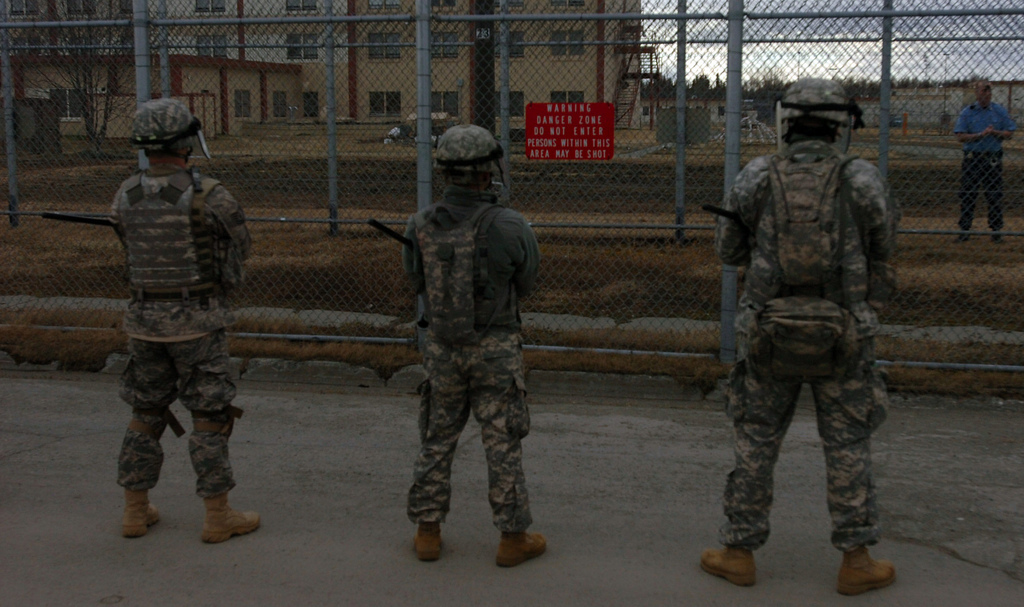
Soldiers and Airmen from the Idaho National Guard lineup outside Wildwood Correctional Facility in Kenai, Alaska, for a natural disaster training exercise during the Alaska National Guard’s Vigilant Guard 2010, April 29. The Soldiers were at Wildwood to simulate assisting local authorities transfer prisoners to the correctional facility due to any type of emergency. Alaska NG VG-2010 is an exercise sponsored by the National Guard Bureau that allows Joint Force Headquarters, Joint Task Forces and various field units to improve command and control and to exercise operational relationships with local, state, regional and federal partners. (NCNG Photo by Army Sgt. Zach Otto; Joint Task Force-Tarheel, North Carolina National Guard)
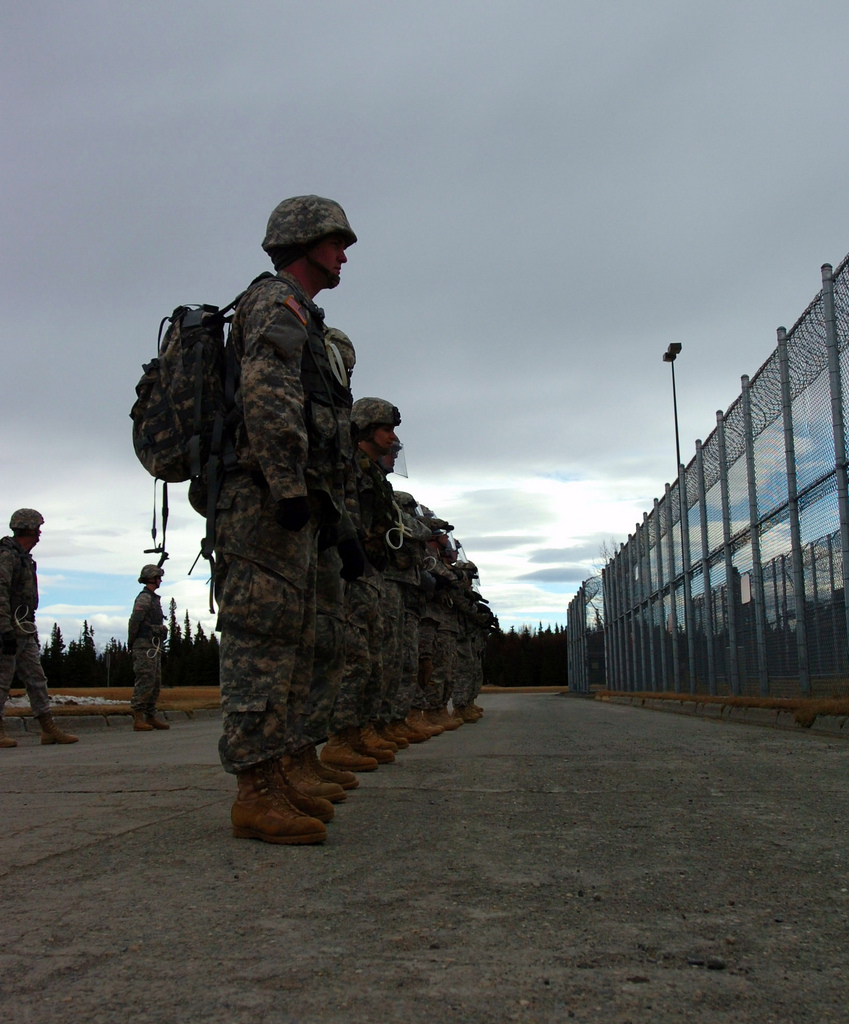
Soldiers and Airmen from the Idaho National Guard lineup outside Wildwood Correctional Facility in Kenai, Alaska, for a natural disaster training exercise during the Alaska National Guard’s Vigilant Guard 2010 exercise, April 29. The Soldiers were at Wildwood to simulate assisting local authorities transferring prisoners to the correctional facility due to another type of emergency. (NCNG Photo by Army Sgt. Zach Otto; Joint Task Force-Tarheel, North Carolina National Guard)
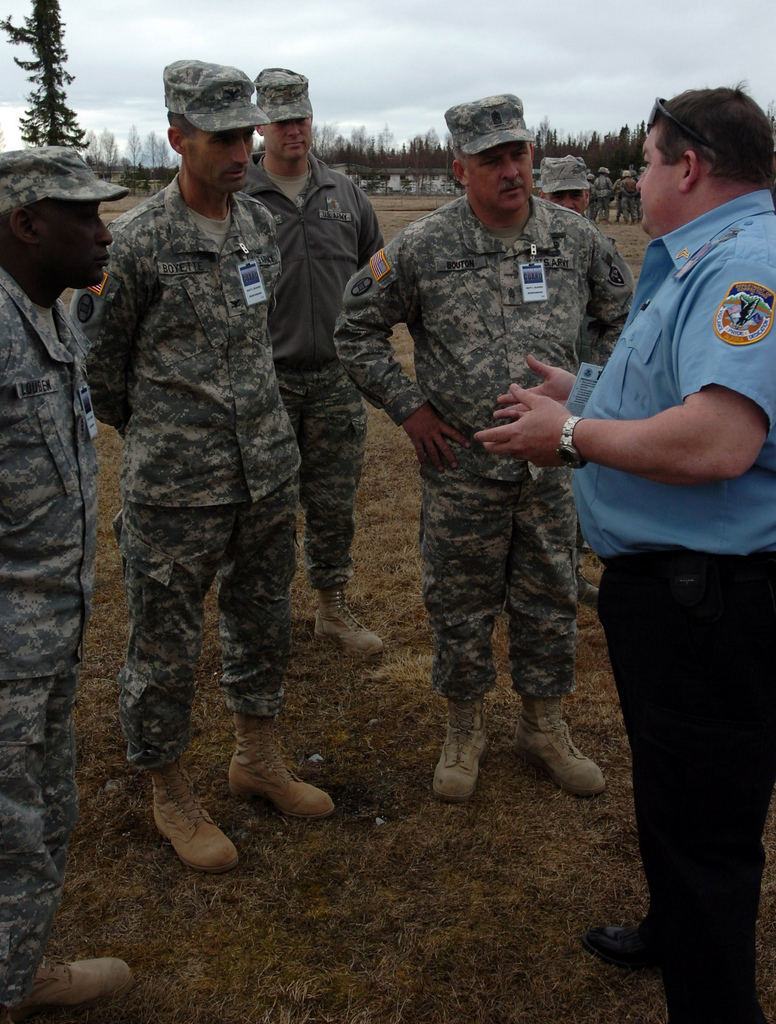
U.S. Army Col. Allen Boyette, Joint Task Force-Tarheel Deputy Commander, Command Sgt. Maj. Ernest Bouton, JTF-Tarheel Command Sergeant Major, and Chief Warrant Officer 3 Mark Louden, JTF-Tarheel Human Resource Officer, talk with Sgt. Dave Cleveland, Alaska Correctional Officer, at the Wildwood Correctional Facility in Kenai, Alaska, during the Alaska National Guard’s Vigilant Guard 2010, April 29. Alaska NG VG-2010 is an exercise sponsored by the National Guard Bureau that allows Joint Force Headquarters, Joint Task Forces and various field units to improve command and control and to exercise operational relationships with local, state, regional and federal partners. (NCNG Photo by Army Sgt. Zach Otto; Joint Task Force-Tarheel, North Carolina National Guard)
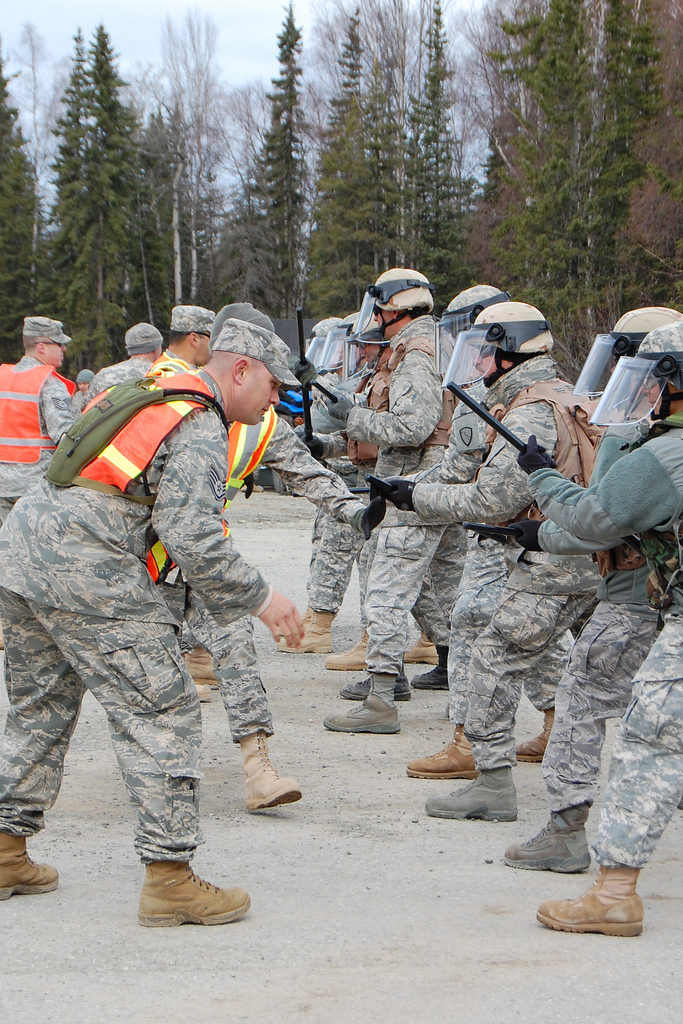
National Guard members from Alaska, Idaho and Oregon participate in riot control training April 26, 2010, at Elmendorf AFB. The 48 Citizen Soldiers and Airman from all three states will receive additional training—non-lethal target practice, and entry control point and convoy operations. The enhanced training is preparation for exercise operations in Kenai at Wildwood Correctional Facility, a local shopping mall, and interacting downtown with civilians in the aftermath of a simulated major earthquake as part of Vigilant Guard, an annual disaster-based training scenario that tests the coordination of National Guard units with local, state, regional, and national disaster preparedness organizations. (Photo by Air Force Maj. Candis Olmstead) (Released)
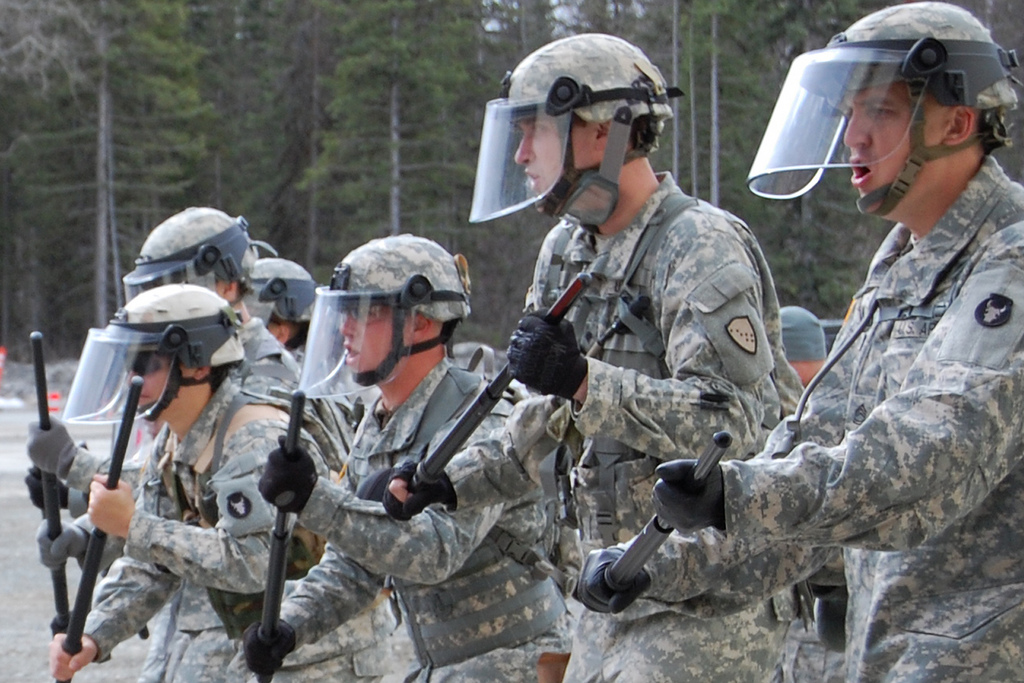
National Guard members from Alaska, Idaho and Oregon participate in riot control training April 26, 2010, at an Elmendorf AFB training site, Forward Operating Base Mad Bull. The 48 Citizen Soldiers and Airman from all three states will receive additional training—non-lethal target practice, and entry control point and convoy operations. The enhanced training is preparation for exercise operations in Kenai at Wildwood Correctional Facility, a local shopping mall, and interacting downtown with civilians in the aftermath of a simulated major earthquake as part of Vigilant Guard, an annual disaster-based training scenario that tests the coordination of National Guard units with local, state, regional, and national disaster preparedness organizations. (Photo by Air Force Maj. Candis Olmstead) (Released)
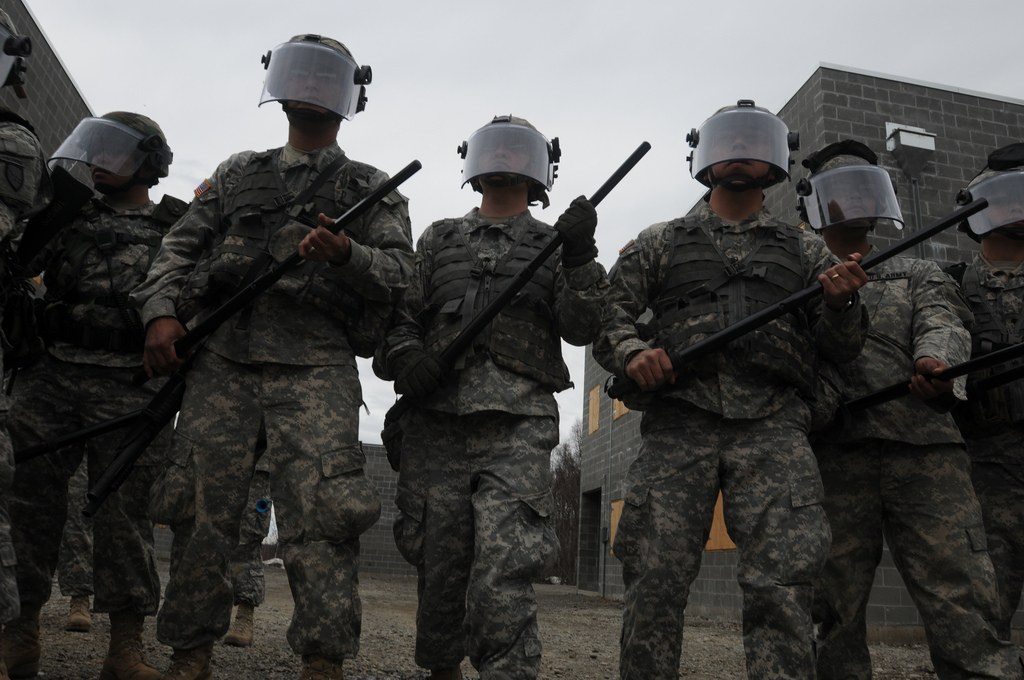
Alaska Army National Guard Soldiers assist Anchorage Police to calm or detain rioters as part of the training scenario of exercise Vigilant Guard Ft. Richardson, Alaska, Wednesday April 28, 2010. Vigilant Guard is an annual, disaster-based training scenario that tests the coordination of National Guard units with local, state, regional, and national disaster preparedness organizations. (U.S. Air Force photo by Tech. Sgt. Brian E. Christiansen, North Carolina National Guard) (Released)
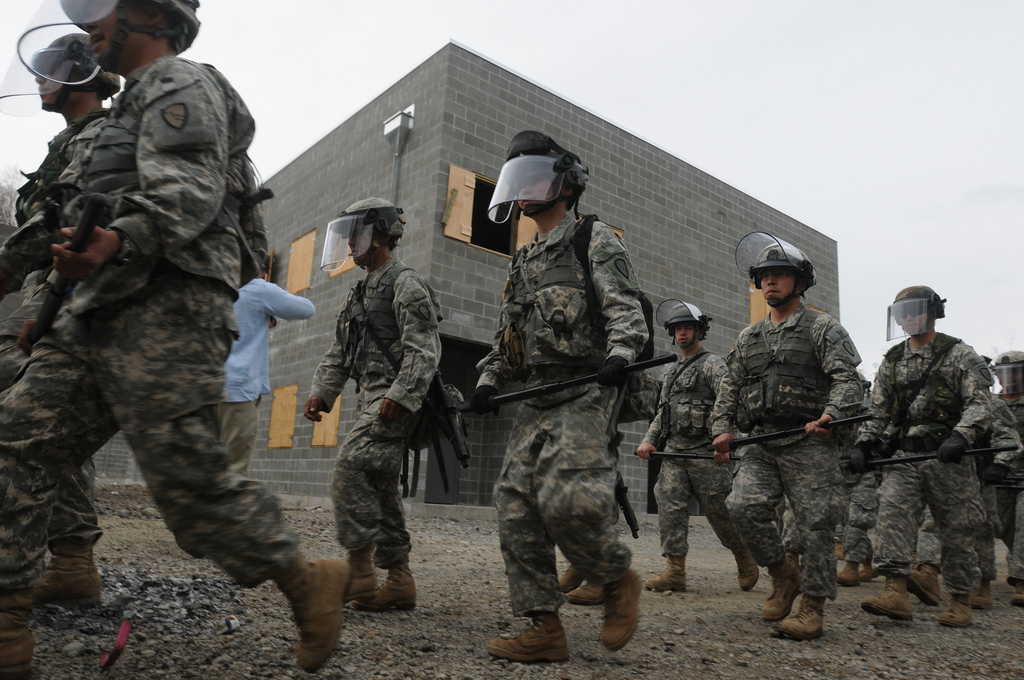
Alaska Army National Guard Soldiers assist Anchorage Police to calm or detain rioters as part of the training scenario of exercise Vigilant Guard Ft. Richardson, Alaska, Wednesday April 28, 2010. Vigilant Guard is an annual, disaster-based training scenario that tests the coordination of National Guard units with local, state, regional, and national disaster preparedness organizations. (U.S. Air Force photo by Tech. Sgt. Brian E. Christiansen, North Carolina National Guard) (Released)
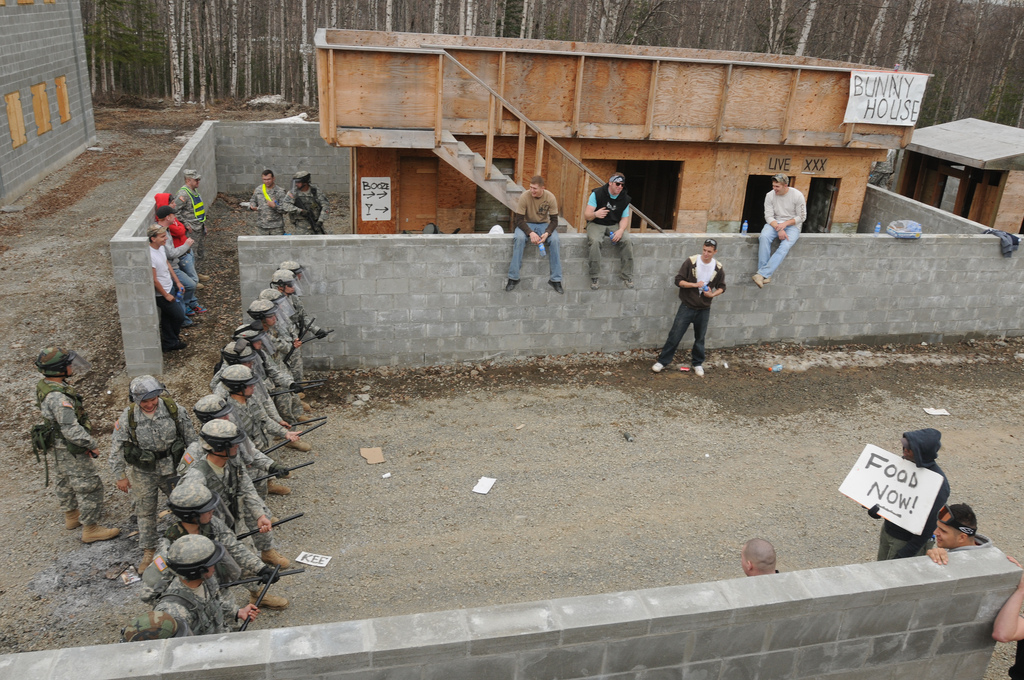
Alaska Army National Guard Soldiers assist Anchorage Police to calm or detain rioters as part of the training scenario of exercise Vigilant Guard Ft. Richardson, Alaska, Wednesday April 28, 2010. Vigilant Guard is an annual, disaster-based training scenario that tests the coordination of National Guard units with local, state, regional, and national disaster preparedness organizations. (U.S. Air Force photo by Tech. Sgt. Brian E. Christiansen, North Carolina National Guard) (Released)
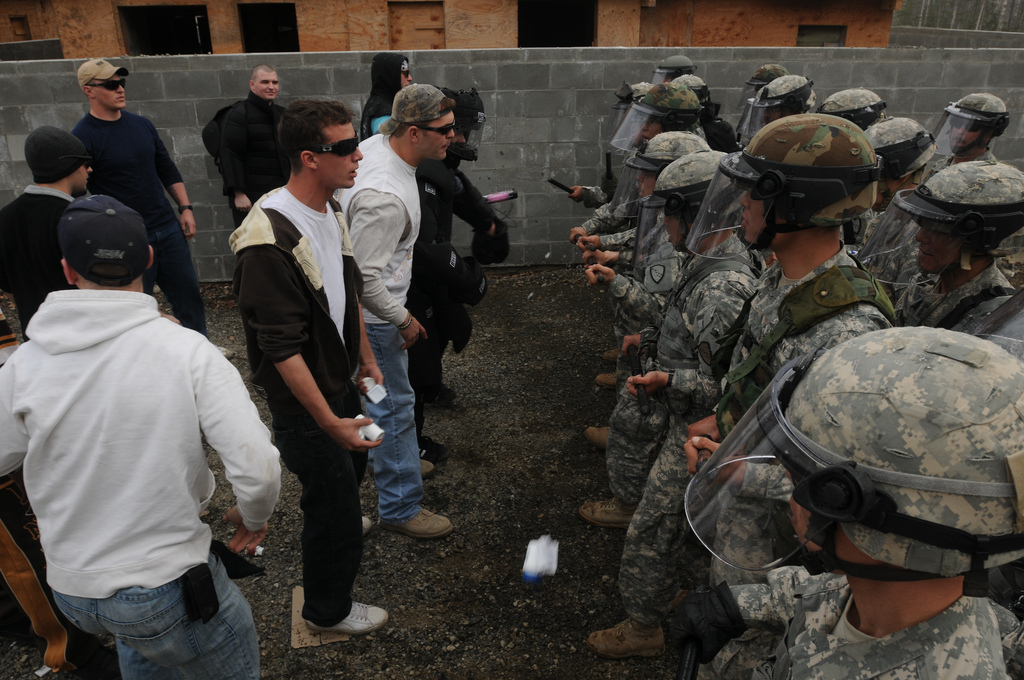
National Guard Soldiers assist Anchorage Police to calm or detain rioters as part of the training scenario of exercise Vigilant Guard Ft. Richardson, Alaska, Wednesday April 28, 2010. Vigilant Guard is an annual, disaster-based training scenario that tests the coordination of National Guard units with local, state, regional, and national disaster preparedness organizations. (U.S. Air Force photo by Tech. Sgt. Brian E. Christiansen, North Carolina National Guard) (Released)
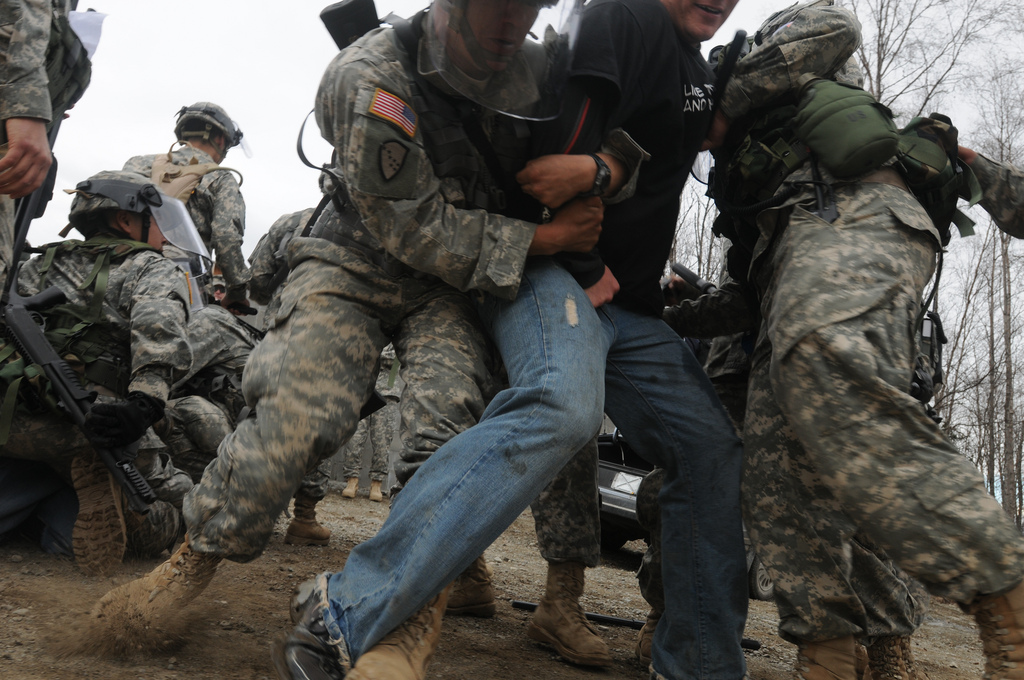
Alaska Army National Guard Soldiers assist Anchorage Police to calm or detain rioters as part of the training scenario of exercise Vigilant Guard Ft. Richardson, Alaska, Wednesday April 28, 2010. Vigilant Guard is an annual, disaster-based training scenario that tests the coordination of National Guard units with local, state, regional, and national disaster preparedness organizations. (U.S. Air Force photo by Tech. Sgt. Brian E. Christiansen, North Carolina National Guard) (Released)
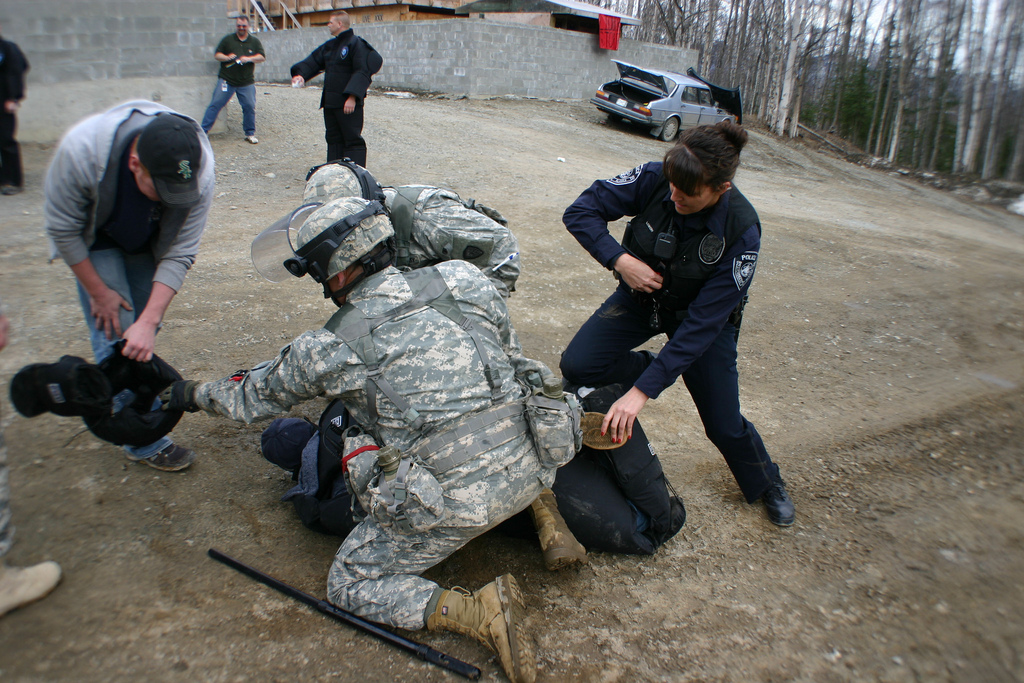
Fort Richardson, AK. — National Guard Soldiers assist Anchorage Police to calm or detain rioters as part of the training scenario of exercise Vigilant Guard Ft. Richardson, Alaska, Wednesday April 28, 2010. Vigilant Guard is an annual, disaster-based training scenario that tests the coordination of National Guard units with local, state, regional, and national disaster preparedness organizations. U.S. Army photo by 1st Sgt. Mike Cummings, 115th MPAD, Oregon Army National Guard (Released)
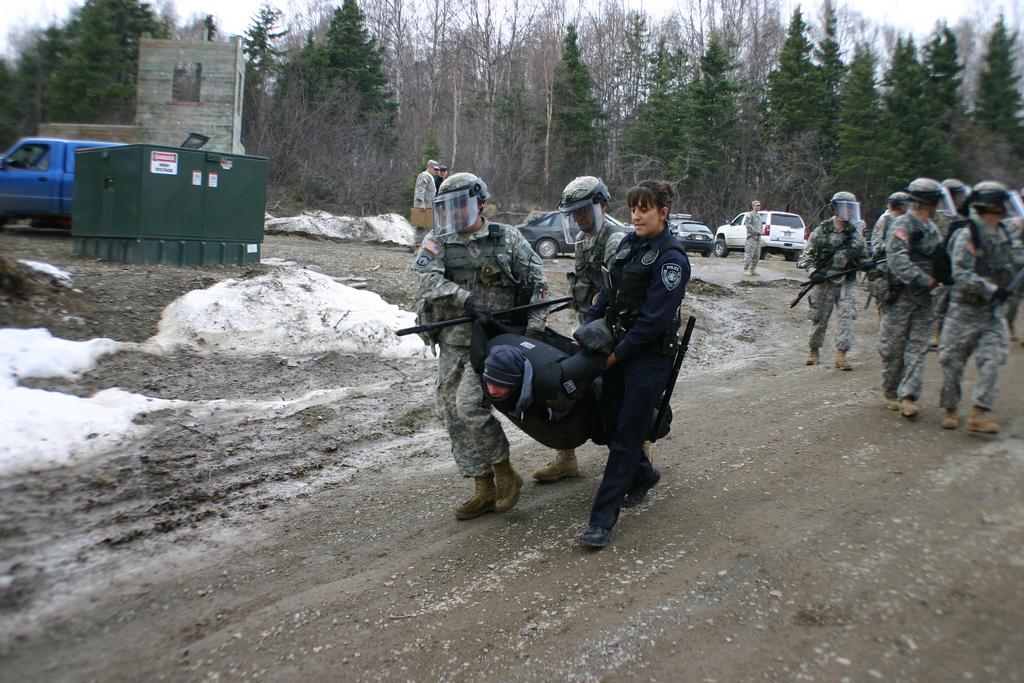
Fort Richardson, AK. — National Guard Soldiers assist Anchorage Police to calm or detain rioters as part of the training scenario of exercise Vigilant Guard Ft. Richardson, Alaska, Wednesday April 28, 2010. Vigilant Guard is an annual, disaster-based training scenario that tests the coordination of National Guard units with local, state, regional, and national disaster preparedness organizations. U.S. Army photo by 1st Sgt. Mike Cummings, 115th MPAD, Oregon Army National Guard (Released)
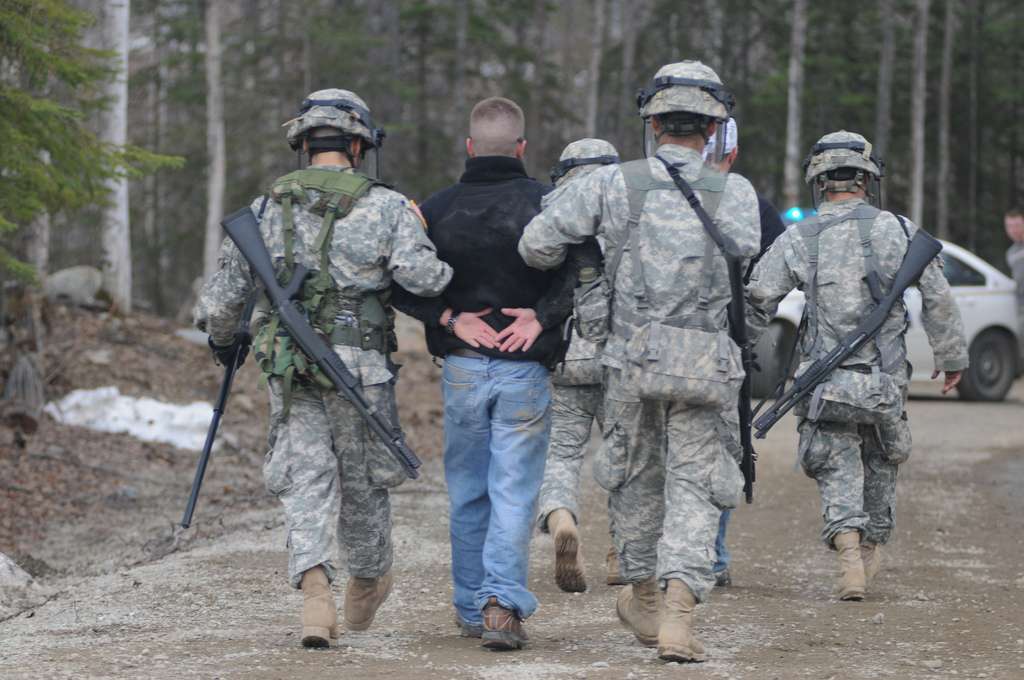
Alaska National Guard Soldiers escort a protestor away after assisting Anchorage Police to calm or detain rioters as part of the training scenario of exercise Vigilant Guard Ft. Richardson, Alaska, Wednesday April 28, 2010. Vigilant Guard is an annual, disaster-based training scenario that tests the coordination of National Guard units with local, state, regional, and national disaster preparedness organizations. (U.S. Air Force photo by Tech. Sgt. Brian E. Christiansen, North Carolina National Guard) (Released)
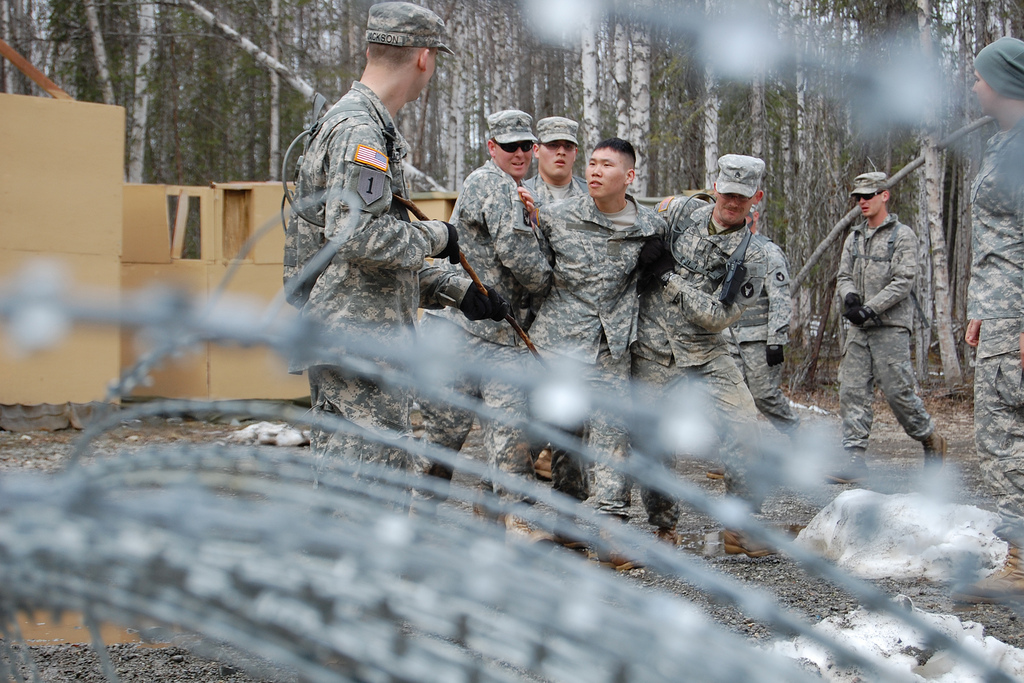
Members of the National Guard from Idaho and Alaska apprehend an insurgent within the secured perimeter at mock Forward Operating Base Mad Bull on Elmendorf AFB during Vigilant Guard Alaska 2010. (Photo by Air Force Maj. Candis Olmstead.)

Members of the National Guard from Idaho and Alaska apprehend an insurgent within the secured perimeter at mock Forward Operating Base Mad Bull on Elmendorf AFB during Vigilant Guard Alaska 2010. (Photo by Air Force Maj. Candis Olmstead.)
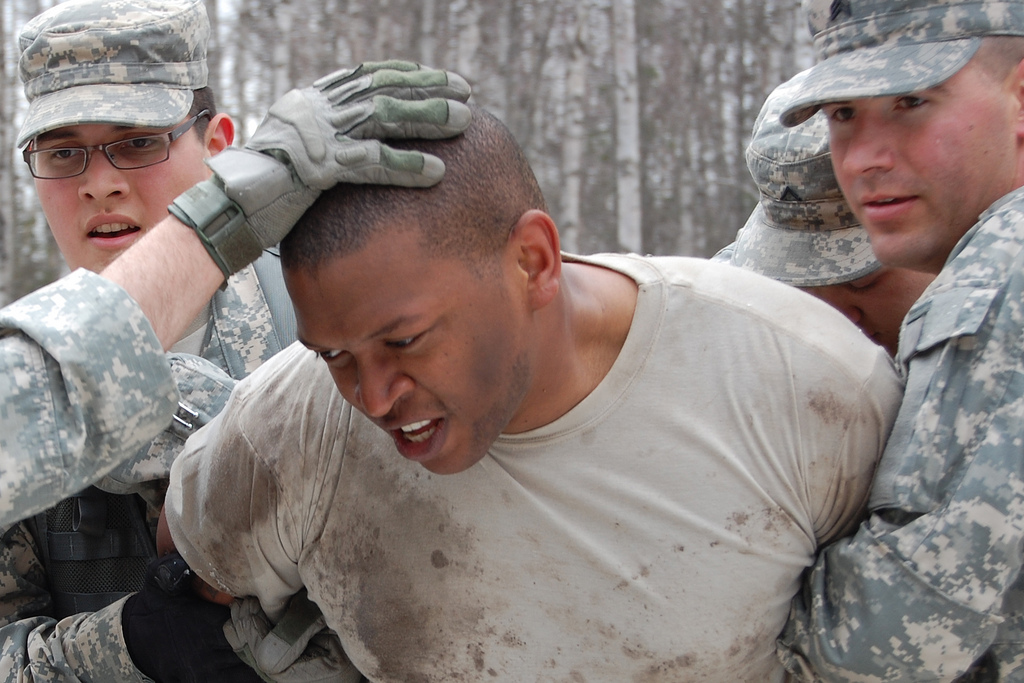
Members of the National Guard from Idaho and Alaska apprehend an insurgent within the secured perimeter at mock Forward Operating Base Mad Bull on Elmendorf AFB during Vigilant Guard Alaska 2010. (Photo by Air Force Maj. Candis Olmstead.)
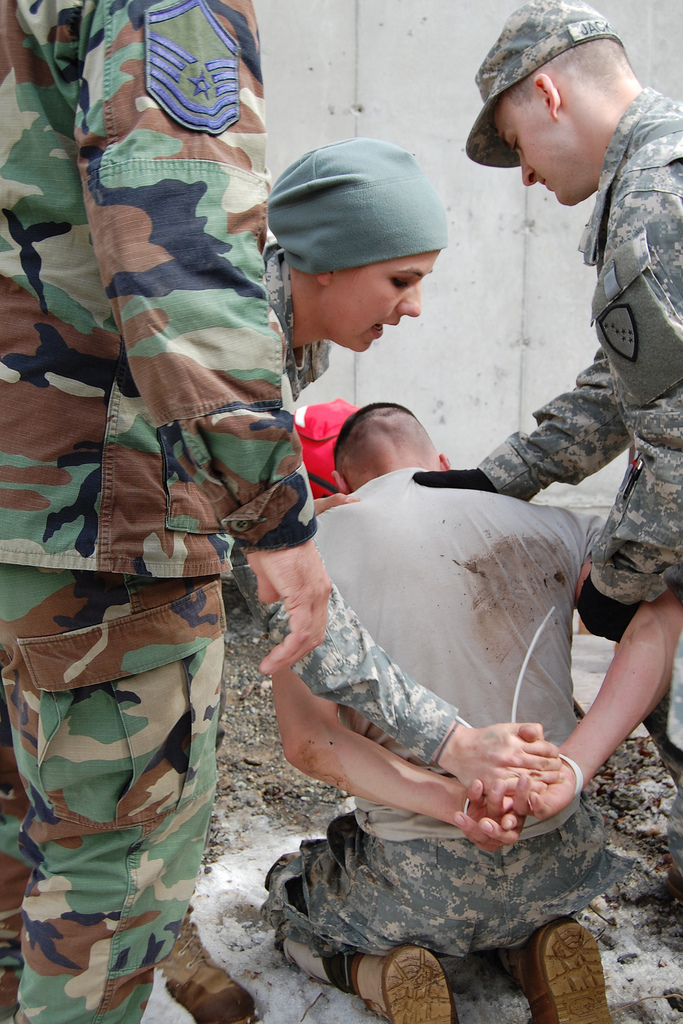
Members of the National Guard from Idaho and Alaska cuff an insurgent outside a mock prison during Vigilant Guard Alaska 2010. (Photo by Air Force Maj. Candis Olmstead.)
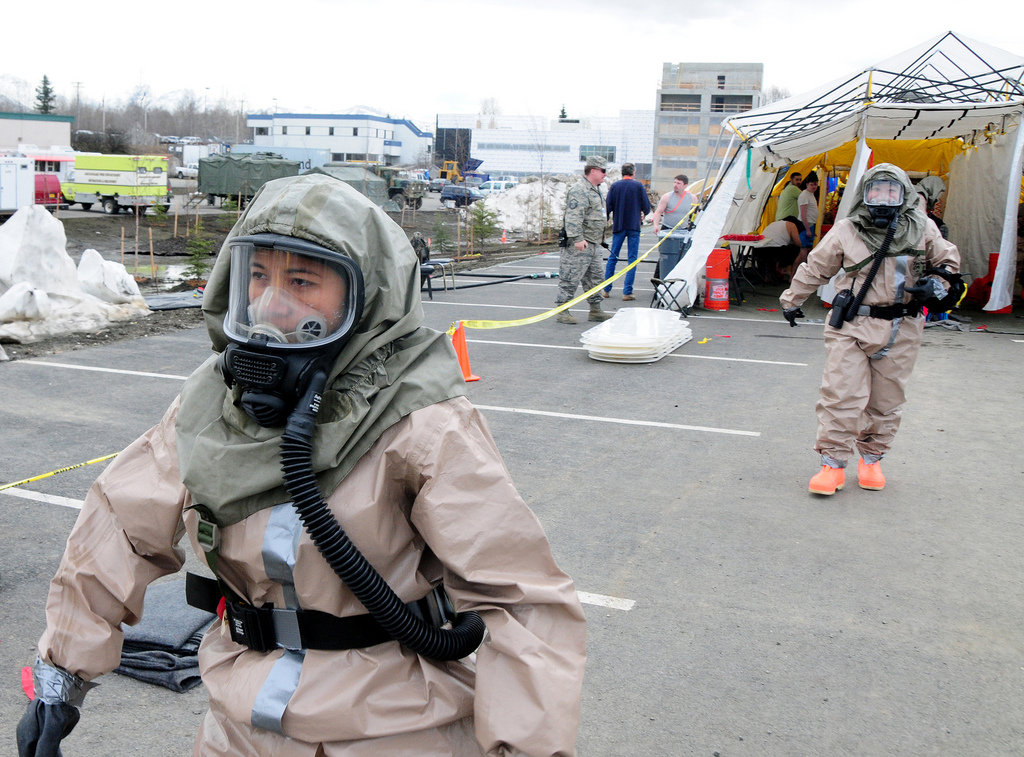
Airman 1st Class Shawna Pascua 154th Medical Group, Hawaii Air National Guard triage specialist during Vigilant Guard heads to triage patients who are simulated to have possibly been contaminated by unknown hazardous materials. Vigilant Guard is a premiere joint training exercise designed to enhance interoperability between federal, state and local volunteer agencies in case of disaster. Photo by Sgt. Karima Turner, Alaska National Guard Public Affairs
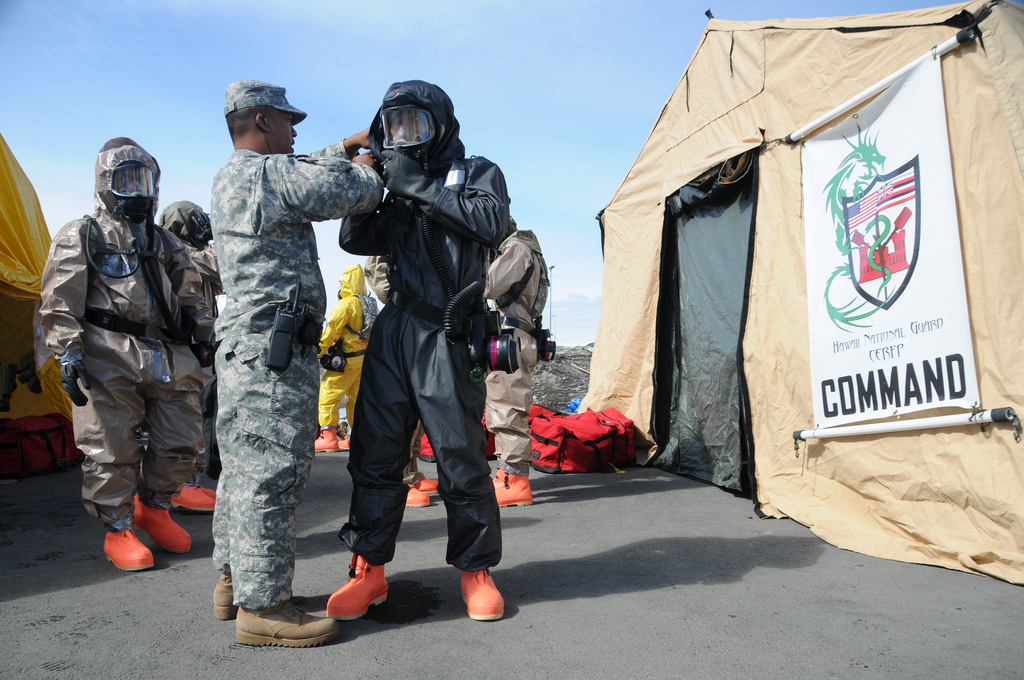
Anchorage, AK. Standing outside the command tent, CPL Jason Nauta, Hawaii Army National Guard, helps PFC Monica Marks with her gloves before giving her clearing her for final inspection, then to assist in removing casulaties during an exercise in Anchorage, Alaska. Nauta is a fulltime technician assigned to the Hawaii Chemical, Biological, Radiological, Nuclear, and high-yield Explosive (CBRNE) Enhanced Response Force Package (CERFP). PAO Released. Air Force Photo by Tech. Sgt. Brian E. Christiansen, N.C. National Guard
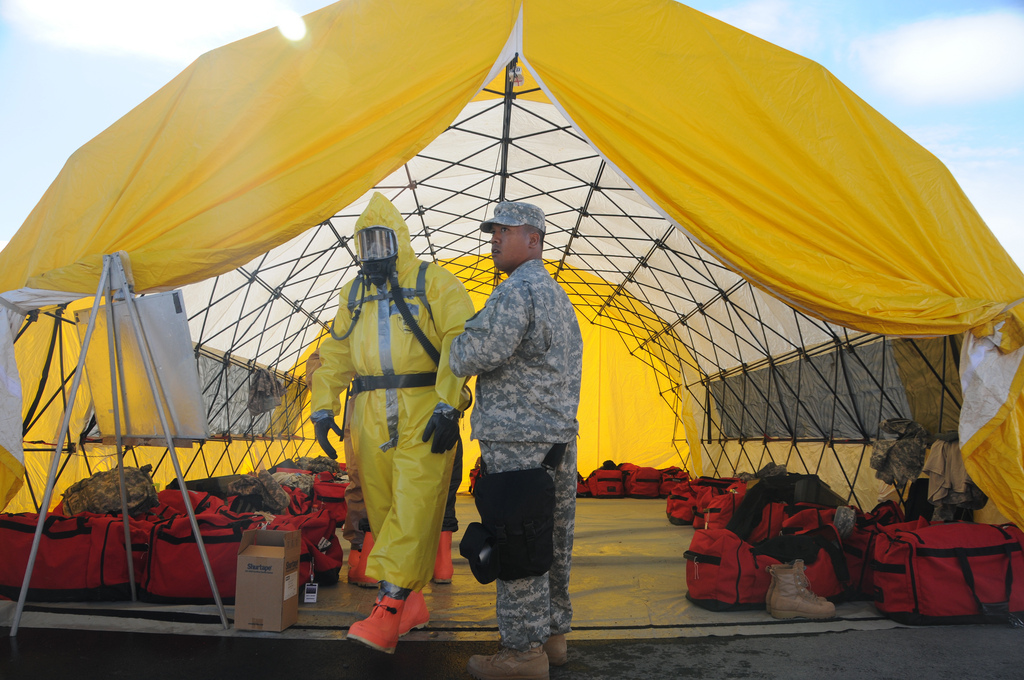
Anchorage, AK. After inspecting his checmical suit, CPL Jason Nauta, Hawaii Army National Guard, clears SPC Terrance Shorter to assist in removing casulaties during an exercise in Anchorage, Alaska. Nauta is a fulltime technician assigned to the Hawaii Chemical, Biological, Radiological, Nuclear, and high-yield Explosive (CBRNE) Enhanced Response Force Package (CERFP). PAO Released. Air Force Photo by Tech. Sgt. Brian E. Christiansen, N.C. National Guard
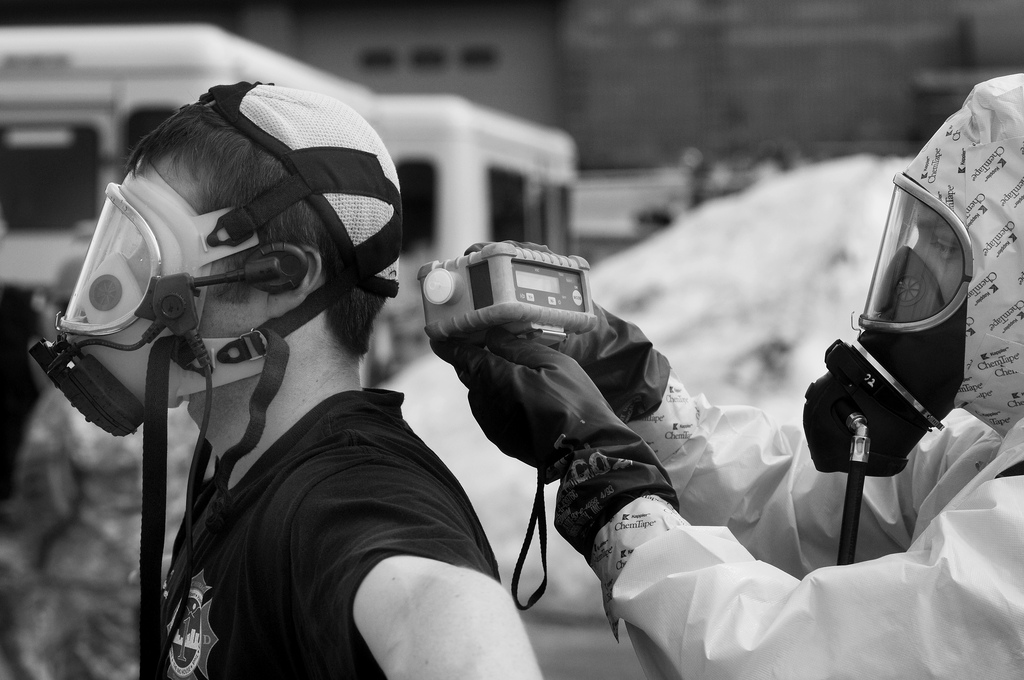
A member of the 103rd Civil Support Team (Weapons of Mass Destruction), right, scans a member of the Anchorage FIre Department for residual chemical agents after responding to a simulated chemical spill as part of the training scenario of exercise Vigilant Guard in Anchorage, Alaska, Monday, April 26, 2010. Vigilant Guard is an annual, disaster-based training scenario that tests the coordination of National Guard units with local, state, regional, and national disaster preparedness organizations. (U.S. Army photo by Sgt. 1st Class Jon Soucy)(Released)
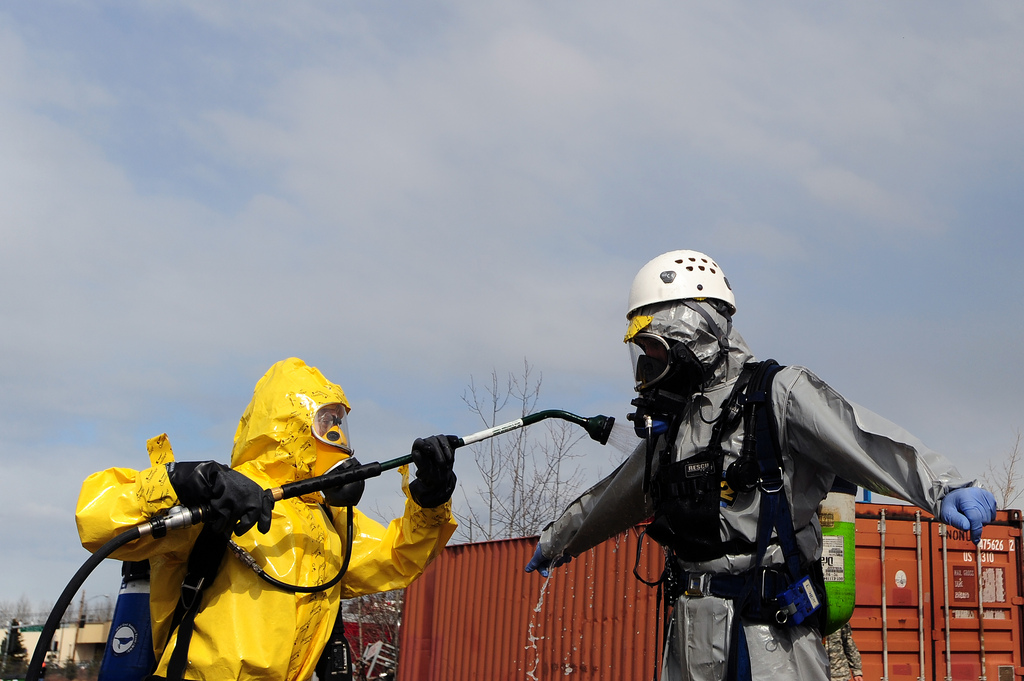
A member of the the 103rd Civil Support Team (Weapons of Mass Destruction), left, decontaminates a local first responder after responding to a simulated chemical spill as part of the training scenario of exercise Vigilant Guard in Anchorage, Alaska, Monday, April 26, 2010. Vigilant Guard is an annual, disaster-based training scenario that tests the coordination of National Guard units with local, state, regional, and national disaster preparedness organizations. (U.S. Army photo by Sgt. 1st Class Jon Soucy)(Released)
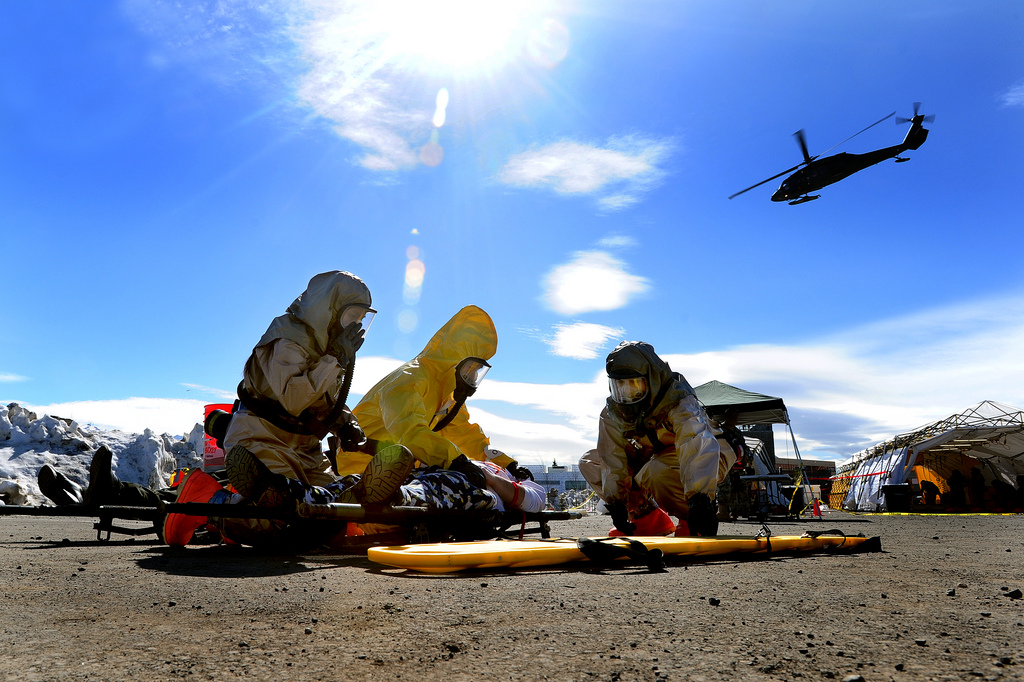
Members of the Hawaii National Guard’s Chemical, Biological, Nuclear and High-Yield Explosives Enhanced Response Force Package prepare patient for movement after extracting him from the rubble of a simulated collapsed parking garage during the training scenario of exercise Vigilant Guard in Anchorage, Alaska, Tuesday, April 27, 2010. Vigilant Guard is an annual, disaster-based training scenario that tests the coordination of National Guard units with local, state, regional, and national disaster preparedness organizations. (U.S. Army photo by Sgt. 1st Class Jon Soucy)(Released)
Author: Mac Slavo
Date: June 15th, 2010
Visit the Author's Website: http://www.SHTFplan.com/

No comments:
Post a Comment